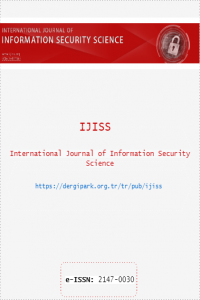Institutional Cybersecurity from Military Perspective
Institutional Cybersecurity from Military Perspective
In the time we are living in, the nonlinear increase, usage and reliability on information communication technologies ICT are going to move forward. In this digital environment, people, institutions and government take necessary precautions ranging from personal to strategic level and adapt themselves to live or operate in that new form of environment. When we consider a country' cybersecurity efforts as a whole, it starts with individuals at the bottom, institutions, firms and military organizations at middle and government at the top. Ensuring a robust cybersecurity policy in a country, requires all levels individual, institution, government to be at the same standard. While the government level cybersecurity strategy documents generally present a comprehensive approach, the institutional level cybersecurity roadmaps, action plans are generally not present or overlooked. Being one of the main elements of a country, military organizations should be prepared to operate in this new form of operational environment that is full of malwares, advance persistent threats APT and cyber espionage software. In this study, institutional cybersecurity from the military perspective is analysed in the light of possible challenges, organizational structure, the military decision making process MDMP and cybersecurity workforce.
Keywords:
Institutional Cybersecurity, military organizations MDMP, cyber operations, cybersecurity workforce,
___
- I. Sisaneci, O. Akin, M. Karaman, and M. Saglam. “A Novel Concept for
- Cybersecurity: Institutional Cybersecurity”, Information Security and Cryptology, Turkey, Ankara, Sep. 20-21, 2013, pp. 89. Conference on
- H. Cintiriz, M. N. Buhur and E. Sensoy. “Military Implications of Big Data”, International Conference on Military İstanbul, War Colleges Command, March 10-11, 2015. ICMSS-2015, Turkey,
- J. Ferwerda, N. Choucri and S. Madnick. “Institutional Foundations for Cyber Security: Current Responses and New Challenges”
- A. Klimburg, Ed., National Cyber Security Framework Manual. NATO CCD COE Publications, 2012.
- B. Adelmann, “Cispa is Big Brother’s Friend,” 2012.
- S. Alexander, “Rise of Outsourcing Poses New Cybersecurity Problems,” 2011.
- B. Gourley, “Open Source Software and Cyber Defense,” 2009.
- “Security Task Force: Public-Private Information Sharing,” 2012.
- L. Ablon, M.C. Libicki and A.A. Golay, Markets for Cybercrime Tools and Stolen Data,
- Open Source Intelligence: A Strategic Enabler of National Security, CSS Analyses in Security Policy, Vol.3, No.32, April 2008.
- M. Karaman, H.Catalkaya. “Institutional Cybersecurity: “A Case Study of Open Source Intelligence and Social Networks”, International Conference on Military Security Studies, Turkey, Istanbul, March 10-11, 2015.
- K. Goztepe. Designing Fuzzy Rule Based Expert System for Cyber Security. International Journal of Information Security Science, 1(1), 2012, pp.13-19.
- Cyberspace Operations, Joint Publication (JP) 3-12 (R), 2013.
- J. Spagnuolo-Loretta, R. Brockway and J.C. Burget. “Risk-Based Assessment and Scoping of IV&V Work Related to Information Assurance”, September 14, 2014.
- Cybersecurity and Cyber Warfare Preliminary Assessment of National Doctrine and Organization, Center for Strategic and International Studies (CSIS), 2011.
- Cyber Electromagnetic Activities, FM 3-38, Department of The Army, Available: https://armypubs.us.army.mil/doctrine/index.html.
- The Operations Process, FM 5-0, Department of The Army, March 2010.
- S.C. Feng and Y. Zhang. “Conceptual Process Planning- A Definition and Functional Decomposition”.
- A.E Kober. “Bridging the Planning Gap: Linking Conceptual Army Design to Military Decision-Making”. School of Advanced Military Studies United States Army Command and General Staff College Fort Leavenworth, Kansas, 2010.
- Military Decision Making Process FM 101-5, Department of The Army.
- Battle Staff Guide. Army National Guard Battle Command Leavenworth, Kansas 66027-2346, August 2010. Center Leavenworth Fort
- I. Kilaz, A. Onder, and M. Yanik. "Manpower Planning and Management in Cyber Defense." 13th European Conference ECCWS‐2014 The University of Piraeus Piraeus, Greece, 2014. Warfare and Security
- O. Akın, et al. “Siber Durum Farkındalıgını Artırmada Etkili Bir Yontem: Bayragı Yakala (Capture the Flag)”, 6th International Conference on Information Security and Cryptology, Turkey, Ankara, Sep. 20-21, 2013.
- Homeland Security Grant Program. Supplemental Resource: Cyber Security Guidance, U.S. Department of Homeland Security, Fiscal year 2014.
- N. Yasar, F.M. Yasar, and Y. Topcu. "Operational Advantages of Using Cyber Electronic Warfare (CEW) in the Battlefield." SPIE Defense, Security, and Sensing. International Society for Optics and Photonics, 2012.
- K. Goztepe. Cyber Defense in Depth: Designing Cyber Security Agency Organization for Turkey. Journal of Naval Science and Engineering 2014, Vol.10, No.1, pp.1- 24.
- K. Goztepe. Recommendations on Future Operational Environments’ Command Control and Cyber Security, 7th International Conference on Information Security and Cryptology, 2014, pp.55-58.
- Yayın Aralığı: Yılda 4 Sayı
- Başlangıç: 2012
- Yayıncı: Şeref SAĞIROĞLU
